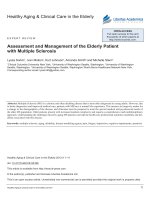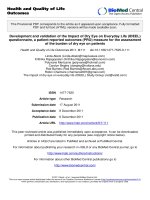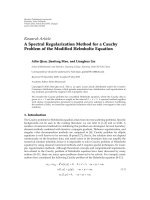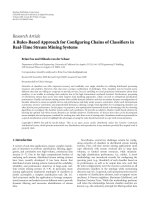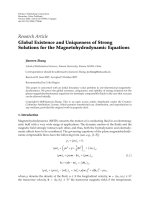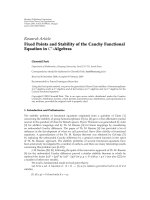Research on pheromone lures and traps for monitoring and management of the fall armyworm spodoptera frugiperda (j e smith) on maize in vinh phuc, vietnam 2020
Bạn đang xem bản rút gọn của tài liệu. Xem và tải ngay bản đầy đủ của tài liệu tại đây (2.07 MB, 86 trang )
VIETNAM NATIONAL UNIVERSITY OF AGRICULTURE
FACULTY OF AGRONOMY
UNDERGRADUATE THESIS
TITLE:
“RESEARCH ON PHEROMONE LURES AND TRAPS FOR
MONITORING AND MANAGEMENT OF THE FALL
ARMYWORM Spodoptera frugiperda (J. E. Smith) ON MAIZE
IN VINH PHUC, VIETNAM 2020”
Student
: PHAM TRUNG KIEN
Code
: 611611
Class
: K61KHCTT
Supervisor
: Dr. TRAN THI THU PHUONG
Department
: ENTOMOLOGY
HA NOI – 2021
THE GUARANTEE
I hereby guarantee that this undergraduate thesis is my research work. The
graduation thesis research data and results are honest and have never been
published. The information cited in this graduation thesis has a clear origin.
Any assistances in implementing this study has been appreciated.
i
ACKNOWLEDGEMENT
In order to complete the undergraduate thesis, in addition to my own
endeavors, I have received enthusiastic support and guidance from teachers, family,
and friends.
First of all, I would like to express my earnest gratitude to Dr. NGUYEN
THI THU PHUONG, Department of Entomology, Vietnam National University of
Agriculture directly instructed me wholeheartedly and helped me in the process of
completing my graduation thesis.
I would like to express my sincere thanks to all the teachers of the
Department of Entomology, Vietnam National University of Agriculture for their
support, making the best conditions for me to implement my graduation thesis.
Finally, I would like to sincerely thank my family, relatives, friends who
have helped and encouraged me throughout the process of doing the thesis.
This thesis is hard to avoid shortcomings. I hope to get the remarks of
teachers and readers. My sincere thanks!
Hanoi, March 4th, 2021
Student
PHAM TRUNG KIEN
ii
TABLE OF CONTENT
THE GUARANTEE ...................................................................................................... i
ACKNOWLEDGEMENT ........................................................................................... ii
TABLE OF CONTENT .............................................................................................. iii
LIST OF ABBREVIATION ....................................................................................... vi
LIST OF TABLE ........................................................................................................ vii
LIST OF FIGURE ...................................................................................................... viii
LIST OF DIAGRAM ................................................................................................... ix
ABSTRACT .................................................................................................................. x
PART I: INTRODUCTION ......................................................................................... 1
1.1. Introduction ........................................................................................................ 1
1.2. Objective and Requirement ............................................................................... 2
1.2.1. Objectives.................................................................................................... 2
1.2.2. Requirements .............................................................................................. 2
PART II: LITERATURE REVIEW ............................................................................ 3
2.1. Research over the World ................................................................................... 3
2.1.1. Taxonomic Tree .......................................................................................... 3
2.1.2. Distribution ................................................................................................. 3
2.1.3. Symptoms .................................................................................................... 4
2.1.4. Damage ....................................................................................................... 5
2.1.5. Description and Life Cycle ........................................................................ 6
2.1.6. Host Range.................................................................................................. 8
2.1.7. Management ............................................................................................... 9
2.1.8. Female sex pheromone of fall armyworm .............................................. 11
2.2. Research in Vietnam........................................................................................ 14
2.2.1. Situation .................................................................................................... 14
2.2.2. Symptoms .................................................................................................. 16
2.2.3. Morphological and biological of fall armyworm ................................... 17
iii
2.2.4. Management ............................................................................................. 17
2.2.5. Sex pheromone application in Vietnam .................................................. 18
PART III: MATERIAL AND METHOD ................................................................. 19
3.1. Objectives and Materials. ................................................................................ 19
3.2. Location and Time ........................................................................................... 19
3.3. Target ................................................................................................................ 19
3.4. Methods ............................................................................................................ 20
3.4.1. Field survey............................................................................................... 20
3.4.2. Method of rearing insect in experiments of biological characteristic of
S. frugiperda........................................................................................................ 21
3.4.3. Method of investigation the method applied pheromone lures and traps
on the field. .......................................................................................................... 23
3.4.4. Calculation methods................................................................................. 27
3.4.5. Data processing ........................................................................................ 28
PART IV: RESULTS AND DISCUSSION ............................................................. 29
4.1. Harmful symptoms of fall armyworm in Vinh Phuc, Hanoi ........................ 29
4.2. Morphological characteristic of fall armyworm ............................................ 30
4.3. Biological characteristic of fall armyworm.................................................... 35
4.3.1 Fall armyworm size ................................................................................... 35
4.3.2. Development time ..................................................................................... 37
4.3.3. Food consuming ability............................................................................ 39
4.3.4. Mortality and sex ratio............................................................................. 40
4.4. Pheromone lure types experiment in Vinh Phuc ........................................... 41
4.5. Pheromone trap types experiment in Vinh Phuc ........................................... 44
4.6. Pheromone trap height experiment in Vinh Phuc.......................................... 48
4.7. Pheromone trap distance experiment in Vinh Phuc ...................................... 49
PART V: CONCLUSION .......................................................................................... 52
5.1. Conclusion........................................................................................................ 52
5.2. Recommendation ............................................................................................. 52
REFERENCES ............................................................................................................ 53
iv
APPENDIX ................................................................................................................. 57
v
LIST OF ABBREVIATION
FAO
Food and Agriculture Organization
CABI
Centre for Agriculture and Biosciences International
FAW
Fall armyworm
TM
Treatment
vi
LIST OF TABLE
Table 2.1. Vietnam corn planted and FAW infected area from October 2019 to
May 2020 ..................................................................................................................... 16
Table 4.1. Head capsule width of larvae fall armyworm Spodoptera frugiperda... 35
Table 4.2. Length, width and weight of pupa and wingspan ranged of male and
female adult fall armyworm Spodoptera frugiperda ................................................ 36
Table 4.3. The development time of male and female adult fall armyworm .......... 38
Table 4.4. Food consuming ability of larvae fall armyworm Spodoptera frugiperda
on maize ....................................................................................................................... 39
Table 4.5. Mortality of fall armyworm in laboratory ................................................ 40
Table 4.6. The density of fall armyworm on the maize field of pheromone
experiment in Vinh Phuc 2020 ................................................................................... 41
Table 4.7. Number of male adult captured in different pheromone lure types in
Vinh Phuc 2020 ........................................................................................................... 43
Table 4.8. The density of fall armyworm on the maize field of pheromone trap
colour and Chinese trap experiment compare to control in Vinh Phuc 2020.......... 45
Table 4.9. Number of male adult captured in different pheromone traps colour
(window) in Vinh Phuc 2020 ..................................................................................... 46
Table 4.10. Number of male adult captured in different pheromone traps colour
(funnel) in Vinh Phuc 2020 ........................................................................................ 47
Table 4.11. The density of fall armyworm on the maize field of pheromone trap
height experiment in Vinh Phuc 2020 ....................................................................... 48
Table 4.12. Number of male adult captured in different pheromone traps height
experiment in Vinh Phuc 2020 ................................................................................... 49
Table 4.13. The density of fall armyworm on the maize field of distance
pheromone trap experiment in Vinh Phuc 2020........................................................ 50
Table 4.14. Number of male adult captured in different pheromone traps distance
experiment in Vinh Phuc 2020 ................................................................................... 50
vii
LIST OF FIGURE
Figure 3.1. Sample scouting pattern for maize .......................................................... 21
Figure 3.2. Rearing fall armyworm eggs in plastic box............................................ 22
Figure 3.3. Mating cage (A); Plastic cage for mating pairs (B) ............................... 23
Figure 3.4. Bucket funnel trap .................................................................................... 25
Figure 3.5. Hand-made trap (funnel) (A); Hand-made trap (windown) (B); Chinese
trap (C) ......................................................................................................................... 25
Figure 4.1. First instar's symptom .............................................................................. 29
Figure 4.2. Second to sixth instar’s symptom ........................................................... 30
Figure 4.3. Egg masses of Fall armyworm ................................................................ 31
Figure 4.4. First instar larvae
Figure 4.5. Second instar larvae............................. 32
Figure 4.6. Third instar larvae
Figure 4.7. Fourth instar larvae ............................ 32
Figure 4.8. Fifth instar larvae
Figure 4.9. Sixth instar larvae................................ 33
Figure 4.10. Pupa of fall armyworm .......................................................................... 34
Figure 4.11. Female adult (A); Male adult (B).......................................................... 34
viii
LIST OF DIAGRAM
Diagram 3.1. Pheromone lure types experiment ....................................................... 24
Diagram 3.2. Pheromone trap colour (windown) experiment .................................. 26
Diagram 3.3. Pheromone trap colour (funnel) experiment ....................................... 26
ix
ABSTRACT
Spodoptera frugiperda (J. E. Smith) (Lepidoptera: Noctuidae) was native to the
Americas and had invaded Vietnam. This study aims to determine specific
pheromone lures, trap types for fall armyworm in Vietnam and evaluate the method
of using pheromone traps for monitoring and management of FAW on maize. The
average life-time of female and male adults FAW were 27.43 and 25.30 days,
respectively. The food consuming of larvae FAW was the highest in 6th instar
770.63 mg/day/larvae. In the study of pheromone types, treatments TM1, TM2,
TM3 attracted more fall armyworm moths than the TM4 and TM5 and more than
USA pheromone lures (TM6, TM7, TM8). Our treatment 3 captured the highest
number male adult FAW in the trap 20.78 moths per trap per day while USA
pheromone lure (TM7) was 13.30±1.81 moths per trap per day. In the experiment
of pheromone trap types, the yellow hand-made (window) traps caught 2.40 moths
per trap per day as much as commercial bucket trap 2.54 moths per trap per day.
The most effective height and distance of pheromone traps were 1.2m (2.13
moths/trap/day) and 40m (2.69 moths/trap/day). Moreover, our result shown that
the density of FAW on maize field applied pheromone traps for 4 weeks was
significant decreased to 0.50±0.22 larvae/m2 while on the maize field without
pheromone traps it was increased to 3.30±0.76 larvae/m2. This result proved
pheromone traps were effective in reducing FAW larvae in the maize field.
x
PART I: INTRODUCTION
1.1. Introduction
The fall armyworm (FAW), Spodoptera frugiperda (J. E. Smith, 1797)
(Lepidoptera: Noctuidae), was recognised as one of the most important noctuid
moth pests of North and South America. In addition, this pest had recently spread
to Africa and had been intercepted in Europe (Montezano et al., 2018) .
In Ethiopia, at the 2017 cropping season, FAW infested more than 24% of
the 2.9 million hectares planted to maize, with a total loss of more than 134,000
tons of crop worth almost $30 million (Beemer, 2018). In Brazil, several tonnes of
insecticidal active ingredients were applied for FAW control each year, and it was
estimated that in maize the annual losses could be between 19 and 100 % (
Montezano et al., 2018).
FAW was first detected in Vietnam in 2019. On August 16, 2019, Ministry
of Agriculture and Rural Development (MARD) reported that 15,000 hectares of
the current maize crop has been infected by FAW in 40 provinces. More than 2,000
hectares are considered to be heavily infected with over eight larvae per square
meter (USDA, 2019).
A pheromone trap is a type of insect trap that uses pheromones to attract
(usually) male insects. Female sex pheromones are chemical secreted by (usually) a
female insect to attract males for mating. Sex pheromones and aggregation
pheromones are the most common types of pheromones in use. Currently, there are
several different pheromone lures being assessed as well as a variety of trap types.
All of these may work, but some pheromone lures also attract a limited number of
non-FAW moths, which may cause some confusion (Prasanna et al., 2018).
The S. frugiperda female releases sex pheromone for attracting the
conspecific male to mate. The sex pheromone component of this species was first
identified as (Z)-9-tetradecenyl acetate (Z9-14:Ac) by (Sekul and Sparks, 1967).
1
The attractive- ness of this compound, however, seemed insufficient. The history of
intensive investigations and field screening for better formulation have been briefly
summarized by Tumlinson et al. (1986). Two components of S. frugiperda sex
pheromone were identified as Z9-14:Ac and (Z)-7-doce- cenyl acetate (Z7-12:Ac)
in a North American (Florida) population (Tumlinson et al., 1986). In addition to
these two components, a third component (E)-7-dodecenyl acetate (E7-12:Ac) was
found in a Brazilian (Sãn Paulo) population (Batista-Pereira et al., 2006).
Because the situation of the fall armyworm (FAW) on maize in Vietnam
recently and the ability to use pheromone traps on FAW management and
prevention had become urgent. On that basis, under the assignment of the
Department of Entomology, Faculty of Agronomy and the guidance of Dr. Tran
Thi Thu Phuong, I conduct research projects: "Research on pheromone lures and
traps for monitoring and management of the fall armyworm Spodoptera
frugiperda (J. E. Smith) on maize in Vinh Phuc, Vietnam 2020".
1.2. Objective and Requirement
1.2.1. Objectives
This research aims to determine specific pheromone lures, trap types for fall
armyworm in Vietnam and evaluate the method of using pheromone traps for
monitoring and management of FAW on maize fields.
1.2.2. Requirements
- Determining morphological and biological of fall armyworm on maize.
- Determining specific pheromone lures, trap types for fall armyworm in
Vinh Phuc, Vietnam
- Identification of pheromone method for FAW in Vinh Phuc, Vietnam
- Determining the evolution of the FAW density on maize in the AutumnWinter crop in 2020 in Yen Lac, Vinh Phuc.
2
PART II: LITERATURE REVIEW
2.1. Research over the World
2.1.1. Taxonomic Tree
Domain: Eukaryota
Kingdom: Metazoa
Phylum: Arthropoda
Subphylum: Uniramia
Class: Insecta
Order: Lepidoptera
Family: Noctuidae
Genus: Spodoptera
Species: Spodoptera frugiperda
(CABI, 2020)
2.1.2. Distribution
The fall armyworm (FAW) is local to tropical and subtropical areas of the
Americas. In North America, this species happened in Bermuda, Canada, American
and Mexico. In South America, this specie present in 12 nations, for example,
Brazin, Argentina, Chile, Columbia, Ecuador, French Guiana, Guyana, Paraguay,
Peru, etc.
In Europe, fall armyworm present in Germany, Netherland and Slovenia. In
Africa, fall armyworm was accounted for without precedent for Central Africa and
West, for instance in Nigeria, Sao Tomé, Benin and Togo in 2016 (Goergen et al.,
2016). In 2019, it harm the yield of 47 African nations as Nigeria, Nambia, Kenya,
Ghana, Ethiopia, Congo, Egypt, Sudan, Zambia, Zimbabwe, etc (Kuate et al.,
2019).
3
In Asia, FAW was first recorded in India and Yemen in 2018. Be that as it
may, in 2019 this species was accounted for happening in over 12 Asia and Asian
nations Bangladesh, China, Korea, Japan, Lao, Malaysia, Myanmar, Nepal,
Philippine, Sri Lanka, Thailand, and Vietnam.
In present, FAW has been distinguished on more than 180 nations and
districts everywhere throughout the world, cause million tons of yields. It's present
from USA to ASIA, become a significant nuisance in numerous sorts of host
plants, particularly on maize plant. In a brief timeframe, the fall armyworm could
make a high harm the economy.
2.1.3. Symptoms
The adult female lays the eggs in masses, randomly distributed within the
crop. During the summer, egg hatch occurs in 2-3 days. The newly hatched larvae
immediately start feeding on the tissues, usually beginning with the tenderest
portions. First instar larvae usually eat the green tissue from one side of the leaf,
leaving the membranous epidermis on the other side intact. Older instars begin to
make holes in the leaf and the fourth to sixth instars may completely destroy small
plants and strip larger ones (Cruz et al., 1999).
Seedlings are fed upon within the whorl. Larger larvae can cut the base of
the plant. Mature plants suffer attack on reproductive structures. Maize leaves are
eaten and the whorl (funnel) may be a mass of holes, ragged edges and larval frass.
Young larvae skeletonize the leaf lamina in a typical 'window-pane' damage.
'Window-paning' is the most common damage symptom at early whorl; however,
this is sometimes indistinguishable from damage that is due to other stem borers.
Usually many young larvae will be present on the same plant, but normally one or
two older larvae may be found on a single plant, as others will migrate and feed on
neighbouring plants. Later larval instars make larger holes, causing ragged whorl
leaves, and produce sawdust-like larval droppings, while fresh feeding produces
4
big lumps. Badly infested fields may look as if they have been hit by a severe
hailstorm. Fall armyworm can also destroy silks and developing tassels, thereby
limiting fertilization of the ear. Maize plants may have the cobs attacked by larvae
boring through the kernels. Damage to cobs may lead to fungal infection and
aflatoxins, and loss of grain quality. At high densities, large larvae may act as
armyworms and disperse in swarms, but they often remain in the locality on wild
grasses, if available (CABI, 2020).
2.1.4. Damage
Larvae cause damage by consuming foliage. Maize plants damaged by the
larvae showed characteristic shot holes on the leaves (Sisodiya et al., 2018). Young
larvae initially consume leaf tissue from one side, leaving the opposite epidermal
layer intact. By the second or third instar, larvae begin to make holes in leaves, and
eat from the edge of the leaves inward. Feeding in the whorl of corn often produces
a characteristic row of perforations in the leaves. Larval densities are usually
reduced to one to two per plant when larvae feed in close proximity to one another,
due to cannibalistic behavior. Older larvae cause extensive defoliation, often
leaving only the ribs and stalks of corn plants, or a ragged, torn appearance.
Marenco et al. (1992) studied the effects of fall armyworm injury to early
vegetative growth of sweet corn in Florida. They reported that the early whorl stage
was least sensitive to injury, the midwhorl stage intermediate, and the late whorl
stage was most sensitive to injury. Further, they noted that mean densities of 0.2 to
0.8 larvae per plant during the late whorl stage could reduce yield by 5 to 20
percent (Capinera, 2020).
Larvae also will burrow into the growing point (bud, whorl, etc.), destroying
the growth potential of plants, or clipping the leaves. In corn, they sometimes
burrow into the ear, feeding on kernels in the same manner as corn earworm,
Helicoverpa zea. Unlike corn earworm, which tends to feed down through the silk
5
before attacking the kernels at the tip of the ear, fall armyworm will feed by
burrowing through the husk on the side of the ear studied larval feeding behavior,
and reported that although young (vegetative stage) leaf tissue is suitable for
growth and survival, on more mature plants the leaf tissue is unsuitable, and the
larvae tend to settle and feed in the ear zone, and particularly on the silk tissues.
However, silk is not very suitable for growth. Larvae attaining the corn kernels
display the fastest rate of development. Also, although the closed tassel was
suitable with respect to survival, it resulted in poor growth. Thus, tassel tissue may
be suitable for initial feeding, perhaps until the larvae locate the silk and ears, but
feeding only on tassel tissue is suboptimal (Capinera, 2020).
2.1.5. Description and Life Cycle
The life cycle is completed in about 30 days during the summer, but 60 days
in the spring and autumn, and 80 to 90 days during the winter. The number of
generations occurring in an area varies with the appearance of the dispersing adults.
The ability to diapause is not present in this species. In Minnesota and New York,
where fall armyworm moths do not appear until August, there may be but a single
generation. The number of generations is reported to be one to two in Kansas, three
in South Carolina, and four in Louisiana. In coastal areas of north Florida, moths
are abundant from April to December, but some are found even during the winter
months (Capinera, 2020).
Egg: The egg is dome shaped; the base is flattened and the egg curves
upward to a broadly rounded point at the apex. The egg measures about 0.4 mm in
diameter and 0.3 mm in height. The number of eggs per mass varies considerably
but is often 100 to 200, and total egg production per female averages about 1500
with a maximum of over 2000. The eggs are sometimes deposited in layers, but
most eggs are spread over a single layer attached to foliage. The female also
deposits a layer of grayish scales between the eggs and over the egg mass,
6
imparting a furry or moldy appearance. Duration of the egg stage is only two to
three days during the summer months (Capinera, 2020)
Larvae: There usually are six instars in fall armyworm. Head capsule
widths are about 0.35, 0.45, 0.75, 1.3, 2.0, and 2.6 mm, respectively, for instars 1 to
6. Larvae attain lengths of about 1.7, 3.5, 6.4, 10.0, 17.2, and 34.2 mm,
respectively, during these instars. Young larvae are greenish with a black head, the
head turning orangish in the second instar. In the second, but particularly the third
instar, the dorsal surface of the body becomes brownish, and lateral white lines
begin to form. In the fourth to the sixth instars the head is reddish brown, mottled
with white, and the brownish body bears white subdorsal and lateral lines. Elevated
spots occur dorsally on the body; they are usually dark in color, and bear spines.
The face of the mature larva is also marked with a white inverted "Y" and the
epidermis of the larva is rough or granular in texture when examined closely.
However, this larva does not feel rough to the touch, as does corn earworm,
Helicoverpa zea (Boddie), because it lacks the microspines found on the similarappearing corn earworm. In addition to the typical brownish form of the fall
armyworm larva, the larva may be mostly green dorsally. In the green form, the
dorsal elevated spots are pale rather than dark. Larvae tend to conceal themselves
during the brightest time of the day. Duration of the larval stage tends to be about
14 days during the summer and 30 days during cool weather. Mean development
time was determined to be 3.3, 1.7, 1.5, 1.5, 2.0, and 3.7 days for instars 1 to 6,
respectively, when larvae were reared at 25ºC (Capinera, 2020).
Pupa: Pupation normally takes place in the soil, at a depth 2 to 8 cm. The
larva constructs a loose cocoon, oval in shape and 20 to 30 mm in length, by tying
together particles of soil with silk. If the soil is too hard, larvae may web together
leaf debris and other material to form a cocoon on the soil surface. The pupa is
reddish brown in color, and measures 14 to 18 mm in length and about 4.5 mm in
7
width. Duration of the pupal stage is about eight to nine days during the summer,
but reaches 20 to 30 days during the winter in Florida. The pupal stage of fall
armyworm cannot withstand protracted periods of cold weather. For example, Pitre
and Hogg (1983) studied winter survival of the pupal stage in Florida, and found 51
percent survival in southern Florida, but only 27.5 percent survival in central
Florida, and 11.6 percent survival in northern Florida (Capinera, 2020).
Adult: The moths have a wingspan of 32 to 40 mm. In the male moth, the
forewing generally is shaded gray and brown, with triangular white spots at the tip
and near the center of the wing. The forewings of females are less distinctly
marked, ranging from a uniform grayish brown to a fine mottling of gray and
brown. The hind wing is iridescent silver-white with a narrow dark border in both
sexes. Adults are nocturnal, and are most active during warm, humid evenings.
After a preoviposition period of three to four days, the female normally deposits
most of her eggs during the first four to five days of life, but some oviposition
occurs for up to three weeks. Duration of adult life is estimated to average about 10
days, with a range of about seven to 21 days (Capinera, 2020).
2.1.6. Host Range
The FAW has a very wide host range, with over 80 plants recorded, but
clearly prefers grasses. The most frequently consumed plants are field maize and
sweet maize, sorghum, Bermuda grass, and grass weeds such as crabgrass
(Digitaria spp). When the larvae are very numerous they defoliate the preferred
plants, acquire the typical “armyworm” habit, and disperse in large numbers,
consuming nearly all vegetation in their path. Many host records reflect such
periods of abundance and are not truly indicative of oviposition and feeding
behavior under normal conditions. Field crops are frequently injured, including
alfalfa, barley, Bermuda grass, buckwheat, cotton, clover, maize, oat, millet,
peanut, rice, ryegrass, sorghum, sugar beet, Sudan grass, soybean, sugarcane,
8
timothy, tobacco, and wheat. Among vegetable crops, only sweet maize is regularly
damaged, but others are attacked occasionally. Other crops sometimes injured are
apple, grape, orange, papaya, peach, strawberry, and a number of flowers. Weeds
known to serve as hosts include bent grass, Agrostis ssp.; crabgrass, Digitaria spp.;
Johnsongrass, Sorghum halepense; morning glory, Ipomoea spp.; nutsedge,
Cyperus spp.; pigweed, Amaranthus spp.; and sandspur, Cenchrus tribuloides
(Prasanna et al., 2018).
According to research in the world of host plants for S. frugiperda. The
literature review and surveys resulted in a total of 353 S. frugiperda larval host
plant records belonging to 76 plant families, principally Poaceae (106), Asteraceae
(31) and Fabaceae (31). Maize, sorghum, and wheat are the main host crops of the
FAW. In addition, they also cause serious harm to many other crops such as
sugarcane, cotton, soybean, peanut, sunflower, onion, garlic, turnip, cruciferae,
cucurbitaceae, tomato, sweet potato, apple, mango etc (Montezano et al., 2018).
2.1.7. Management
* Sampling: Moth populations can be sampled with black light traps and
pheromone traps; the latter are more efficient. Pheromone traps should be
suspended at canopy height, preferably in corn during the whorl stage. Catches
are not necessarily good indicators of density, but indicate the presence of moths
in an area. Once moths are detected it is advisable to search for eggs and larvae.
A search of 20 plants in five locations, or 10 plants in 10 locations, is generally
considered to be adequate to assess the proportion of plants infested. Sampling
to determine larval density often requires large sample sizes, especially when
larval densities are low or larvae are young, so it is not often used (Capinera,
2020).
* Insecticides: Insecticides are usually applied to sweet corn in the
southeastern states to protect against damage by fall armyworm, sometimes as
9
frequently as daily during the silking stage. In Florida, fall armyworm is the
most important pest of corn. It is often necessary to protect both the early
vegetative stages and reproductive stage of corn. Because larvae feed deep in the
whorl of young corn plants, a high volume of liquid insecticide may be required
to obtain adequate penetration. Insecticides may be applied in the irrigation
water if it is applied from overhead sprinklers. Granular insecticides are also
applied over the young plants because the particles fall deep into the whorl.
Some resistance to insecticides has been noted, with resistance varying
regionally. Foster (1989) reported that keeping the plants free of larvae during
the vegetative period reduced the number of sprays needed during the silking
period. The grower practice of concentrating the sprays at the beginning of the
silking period instead of spacing the sprays evenly provided little benefit
(Capinera, 2020).
* Cultural techniques: The most important cultural practice, employed
widely in southern states, is early planting and/or early maturing varieties. Early
harvest allows many corn ears to escape the higher armyworm densities that
develop later in the season (Mitchell 1978). Reduced tillage seems to have little
effect on fall armyworm populations (All 1988), although delayed invasion by
moths of fields with extensive crop residue has been observed, thus delaying and
reducing the need for chemical suppression (Capinera, 2020).
* Host plant resistance: Partial resistance is present in some sweet corn
varieties, but is inadequate for complete protection (Capinera, 2020).
* Biological control: Although several pathogens have been shown
experimentally to reduce the abundance of fall armyworm larvae in corn,
only Bacillus thuringiensis presently is feasible, and success depends on having
the product on the foliage when the larvae first appear. Natural strains
10
of Bacillus thuringiensis tend not to be very potent, and genetically modified
strains improve performance (Capinera, 2020).
2.1.8. Female sex pheromone of fall armyworm
A pheromone trap is a type of insect trap that uses pheromones to attract
(usually) male insects. A pheromone is a chemical secreted by (usually) a female
insect to attract males for mating. Pheromones can travel by air very long distances
and hence are very useful for monitoring insect presence. Sex pheromones and
aggregation pheromones are the most common types of pheromones in use.
Currently there are several different pheromone lures being assessed as well as a
variety of trap types. All of these may work, but some pheromone lures also attract
a limited number of non-FAW moths, which may cause some confusion (Prasanna
et al., 2018).
The S. frugiperda female releases sex pheromone for attracting the
conspecific male to mate. The sex pheromone component of this species was first
identified as (Z)-9-tetradecenyl acetate (Z9-14:Ac) by (Sekul and Sparks, 1967).
The attractive- ness of this compound, however, seemed insufficient. The history of
intensive investigations and field screening for better formulation have been briefly
summarized by (Tumlinson et al., 1986). Two components of S. frugiperda sex
pheromone were identified as Z9-14:Ac and (Z)-7-doce- cenyl acetate (Z7-12:Ac)
in a North American (Florida) population (Tumlinson et al., 1986) .In addition to
these two components, a third component (E)-7-dodecenyl acetate (E7-12:Ac) was
found in a Brazilian (Sãn Paulo) population (Batista-Pereira et al., 2006).
Pheromones can be used in four strategies in integrated pest management
programs, specifically monitoring, mass trapping, attraction annihilation, and
mating disruption. Trap variables, such as design, size, and color are important
features, along with the attractant, in the first three strategies. Ideally, traps should
11
be easy to use, of standard construction, and inexpensive. When a trap is
constructed, characteristics such its design, size, and color in relation to the insect
behavior should be considered . A variety of traps have been designed for several
insect pests and many of them are commercially available. However, a number of
biological and environmental factors can affect traps efficiency and use in insect
pest management programs. Trap color may influence the number of target insects,
including predators, parasitoids, and pollinators. Attraction of beneficial insects to
trap colors needs to be addressed during trap development in order to minimize
nontarget effects.
Commercially available sex pheromone-baited traps have been used in a
number of countries for monitoring the fall armyworm (FAW), Spodoptera
frugiperda (J. E. Smith), males in corn fields. For example, in the United States, S.
frugiperda males are frequently monitored with plastic funnel traps (e.g., Universal
moth traps, bucket traps, or uni- traps). However, funnel traps had a poor efficiency
compared to Scentry Heliothis and delta traps in catching FAW males in the coastal
plain of Chiapas, Mexico. Scentry Heliothis trap was the most effective trap in
capturing FAW males in corn and sorghum fields in Mexico. Nevertheless, this
kind of trap is expensive and prone to be stolen or destroyed, which may limit its
use in some areas of Mexico (Malo et al., 2018).
Monitoring, surveillance, and scouting are critical activities to support a
successful integrated pest management program that includes resistant varieties,
biological control, and cultural control strategies. Monitoring actively tracks the
presence, population size, and movement of a pest and for fall armyworm, it is best
achieved using pheromone-based traps that attract male moths. Adult males have
been monitored for over 40 years with commercial versions of female-produced
sex pheromones as lures, but there are several pheromone blends and styles of traps
that are available and the various combinations may provide conflicting results
12
among geographic regions. Field studies in the USA and Central America have
shown that the chemicals needed for attraction were two acetates, (Z)-9tetradecenyl acetate (Z9-14:Ac) and (Z)-7-dodecenyl acetate (Z7-12: Ac) (Meagher
et al., 2013). The addition of two other acetates, (Z)-11- hexadecenyl acetate (Z1116:Ac) and (Z)-9-dodecenyl acetate (Z9-12:Ac), did not improve attraction
ofmoths to traps (Meagher et al., 2013). Studies in Brazil found that the E isomer of
dodecenyl acetate (E7-12:Ac) significantly increased trap capture. These results
indicate that there may be regional differences in the attractiveness of pheromone
blends.
Differences in pheromone lure composition are also known to influence the
number of non-target insects that are collected. This was shown to be an important
consideration for monitoring fall armyworm in North America. In Florida, nontarget moths rarely comprise more than 10% of the total captures, but experiments
in the northeastern USA showed that commercial lures containing three or four fall
armyworm pheromone components attracted large numbers (38–48% of total
captures) of the non-target species Leucania phragmatidicola. Traps baited with
two-component lures (Z9-14:Ac and Z7-12:Ac) had low L. phragmatidicola
captures (0.5–1.4%) but also captured fewer S. frugiperda. Additional screening or
handling of trap samples and possible misidentification of target species decreases
the efficiency and value for the monitoring system.
Spodoptera frugiperda (J.E. Smith) (Lepidoptera: Noctuidae) has recently
invaded
Okinawa,
Japan
via
Africa,
South
Asia
and
China.
Gas
chromatography/mass spectrometry analyses of hexane extracts of 100 abdominal
glands of Okinawan females revealed six candidate compounds for sex pheromone,
(Z)-9-tetradecenyl acetate (Z9-14:Ac, ca. 6 ng/female), (Z)-11-hexadecenyl acetate,
(Z)-11-tetradecenyl acetate, (Z)-7-dodecenyl acetate (Z7-12:Ac), (E)-9-dodecenyl
acetate, and (Z)-9-tetradecen-1-ol at the ratio of 100:10:1.3:0.90:0.13:1.8,
13
respectively. In Okinawa, only small numbers of males were captured with the
original blend of these compounds. However, much more males were attracted to a
100:3 blend of Z9-14:Ac and Z7-12:Ac that had been suggested by others to be the
most effective blend in a Florida population. In another test in Okinawa, even more
males were captured with a 100:1 blend of these compounds than with a 100:3
blend. Significant numbers of males of other moths, Mythimna loreyi (Duponchel)
and Chrysodeixis eriosoma (Doubleday), were also attracted to blends of Z9-14:Ac
and Z7-12:Ac when the ratio of the latter to the former compound was increased
from 100:1 to 100:10. Based on these results that had the most powerful as well as
convenient sex pheromone formulation to monitor S. frugiperda populations in
Okinawa was a 100:1 blend of Z9-14:Ac and Z7-12:Ac (Wakamura et al., 2020).
Trap design may also influence moth capture and can significantly affect the
cost of a monitoring system. Plastic bucket traps are commonly used for fall
armyworm and are available from several sources. Moths are contained in the
enclosed bucket and are killed with the use of a fumigant (Meagher et al., 2019).
2.2. Research in Vietnam
2.2.1. Situation
In Vietnam, maize (Zea mays L.) is the second food crop after rice. The
country's corn acreage is estimated at 1.1 million hectares, productivity is estimated
at 46.7 quintals/hectare, and output is 5.13 million tons (Crop Industry Report
2017). In recent years, many State policies along with the application of scientific
and technical advances in production (using new hybrid maize varieties with high
yield potential, etc) have contributed to increase maize yield. However, the
investment in intensive farming, changing the structure of maize varieties leads to
more and more harmful organisms, significantly reducing productivity, such as
corn borer, corn leaf borer, thorn worm, and gray worm, etc. In particular, the fall
armyworm Spodoptera frugiperda (FAW) that recently entered Vietnam is in
14
